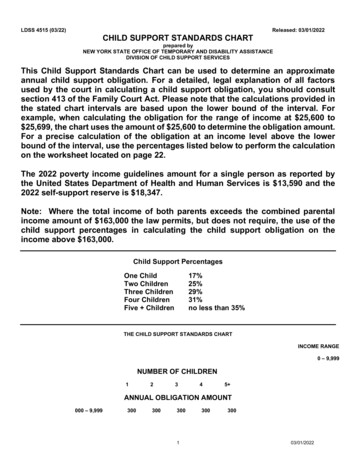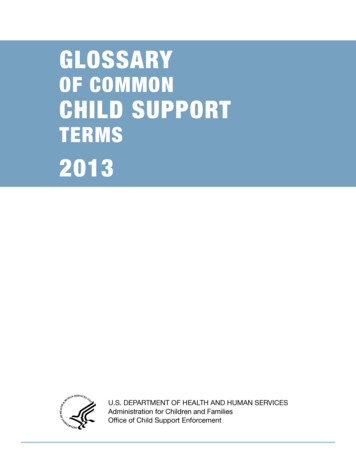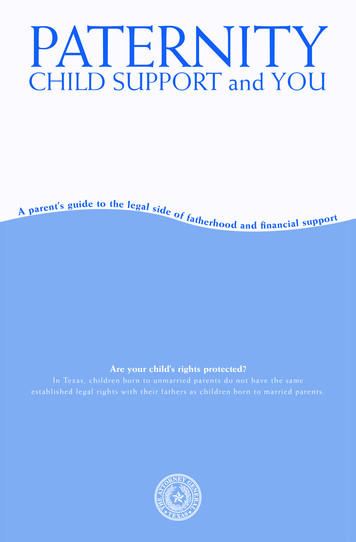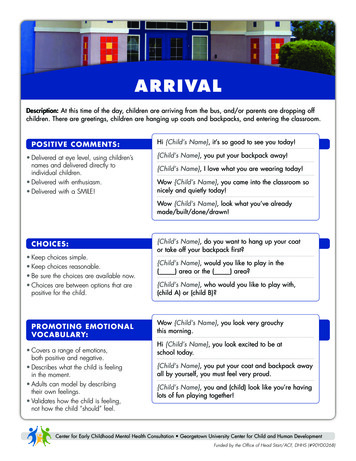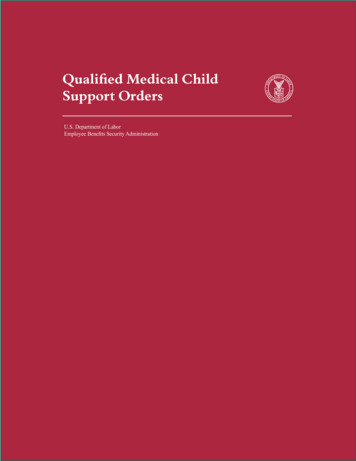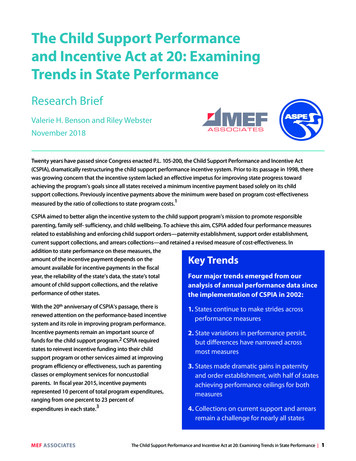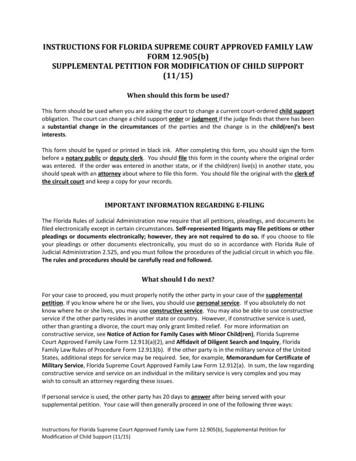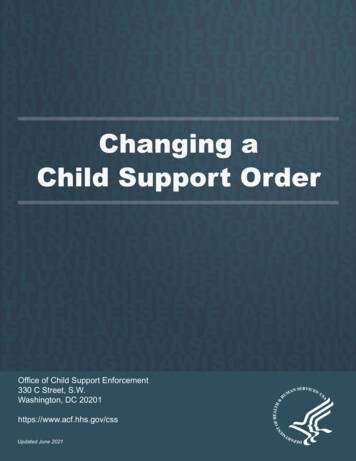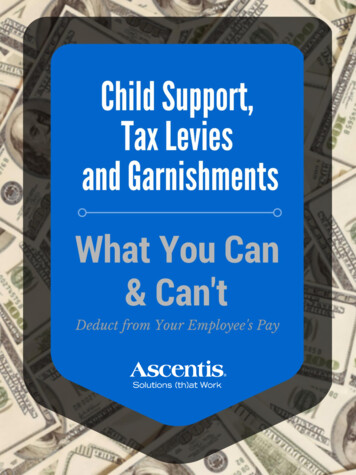
Transcription
Ch 1:Ch 2:Ch 3:Child SupportTax LeviesGarnishmentsThis guide is provided “as is” without warranty of any kind. It is not intended toprovide legal or tax advice. Ascentis has taken reasonable steps to ensure thatthis information is accurate and timely. Please consult with an employmentlaw or tax attorney with questions that pertain to your unique businessenvironment and industry.
The Law:Federal law requires employers to report information about newlyhired and rehired employees to a designated state agency within 20days of hire. State law may require you to report sooner.You must report the required seven elements (employee name, SSN,address, date of hire and the employer’s name, address, and FEIN),with some states requiring additional information.You must report employees you previously employed and who returnafter having been separated for at least 60 consecutive days. In somestates, the timeframe is even shorter than the federal minimum.
The CCPC (Consumer Credit Protection Act) limits the amount thatcan be deducted from “disposable pay” for child support and these*limits apply even if more than one garnishment (child support, plusanother type, or even multiple child support orders) is in effectFederal Law, in the Consumer Credit Protection Act, (CCPA), 15 USC1673(b)(2) says:2) The maximum part of the aggregate disposable earnings of an individual for anyworkweek which is subject to garnishment to enforce any order for the support ofany person shall not exceed:(A) where such individual is supporting his spouse or dependentchild (other than a spouse or child with respect to whose support suchorder is used), 50 per centum of such individual's disposable earningsfor that week; and(B) where such individual is not supporting such a spouse or dependentchild described in clause (A), 60 per centum of such individual'sdisposable earnings for that week; except that, with respect to thedisposable earnings of any individual for any workweek, the 50 percentum specified in clause (A) shall be deemed to be 55 per centum andthe 60 per centum specified in clause (B) shall be deemed to be 65 percentum, if and to the extent that such earnings are subject togarnishment to enforce a support order with respect to a period which isprior to the twelve-week period which ends with the beginning of suchworkweek.*Limits do not apply to federal or state tax levies
In a nutshell, this means that the CCPA limits are up to 50 percent of aworker's disposable earnings to be garnished for these purposes if theworker is supporting another spouse or child, or up to 60 percent ifthe worker is not. An additional 5 percent may be garnished forsupport payments more than 12 weeks in arrears.Allowable disposable income is the maximum available for childsupport withholding. In most cases, the amount ordered to bewithheld will be less than the allowable disposable income amount,and the ordered amount can be withheld without any problem. Even ifthe withholding order specifies a higher payment, the allowabledisposable income is the most that may be withheld.
Multi-state notices – calculation exampleCalculating withholding amounts for two states within CCPA limitswhen both notices are for fixed-dollar amounts.Scenario: Wisconsin notice is for 200 per monthMinnesota notice is for 350 per monthEmployee’s gross income is 900/monthEmployee’s CCPA limit is 55% of disposable incomeDisposable income is 750/monthCalculation: Employee’s CCPA limit is 55% of disposable income: 55% x 750 412.50Total amount due per notices: 550 ( 200 350) is above the CCPAlimitsWisconsin notice is 36% of total ( 200/ 550)Minnesota notice is 64% of total ( 350/ 550)Prorated amount for Wisconsin notice: 36% of 412.50 148.50Prorated amount for Minnesota notice: 64% of 412.50 264Withhold 148.50 and remit to Wisconsin andWithhold 264 and remit to Minnesota
State/ TerritoryLink to loradoConnecticutDelawareDistrict of settsMichiganMinnesotaRule 32, Alabama Rules of Judicial AdministrationRule 90.3, Alaska Civil RuleArizona Child Support GuidelinesAdministrative Order of the Supreme Court No. 10California Family Code §§ 4050-4076Colorado Rev. Stat. §§ 14-10-115 et seq.Child Support and Arrearages Guidelines13 Delaware Code §514D.C. Code Ann. § 16-916.1Florida Title VI, Chapter 61.30Georgia Child Support GuidelinesGuam Child Support GuidelinesHawaii Child Support GuidelinesIdaho R. Civ. Pro. 6(c)(6)750 ILCS Illinois Child Support GuidelinesIndiana Child Support Rules and GuidelinesIowa Child Support GuidelinesKansas Child Support GuidelinesKentucky Rev. Stat. §§ 403-210 to -213Louisiana Rev. Stat. 9:315.1 et seq.Maine Rev. Stat. Ann. tit. 19-A, §§ 2001-2010Maryland Fam. Law Code Ann. §§ 12-201 et seq.Massachusetts Child Support GuidelinesMichigan Child Support Formula ManualMinn. Stat. Ann. §§ 518A.35 et seq.
State/ ew HampshireNew JerseyNew MexicoNew YorkNorth CarolinaNorth DakotaOhioOklahomaOregonPennsylvaniaRhode IslandSouth CarolinaSouth est VirginiaWisconsinWyomingLink to GuidelinesMiss. Code §§ 43-19-101 et seq.Section 452.340Montana Child Support GuidelinesNebraska Court Rules Chapter 4, Article 2, §§ 4-201 to 4-220Nev. Rev. Stat. §§ 125B.070 to -.080N.H. Rev. Stat. §§ 458-C:1 to -:7New Jersey Rules of Court Appendix IXN.M. Stat. §§ 40-4-11.1 to -11.6N.Y. Dom. Rel. Law. § 240(1-b)North Carolina Child Support GuidelinesNorth Dakota Child Support GuidelinesOhio Rev. Code §§ 3119.01 et seq.Okla. Stat. tit. 43, §§ 118 to 120Oregon Child Support GuidelinesPa. R. Civ. Pro. 1910.16-1 to -5R.I. C.S.G. Administrative OrderSouthern Carolina Soc. Serv. Reg. 114-4710 to -4750South Dakota Cod. Laws §§ 25-7-6.1 et seq.Tennessee Child Support GuidelinesTex. Fam. Code §§ 154.001 et seq.Utah Code §§ 78B-12 et seq.Vt. Stat. title 15, §§ 653-657Va. Code §§ 20-108.1, 20-108.2Wash. Rev. Code §§ 26.19.001 et seq.West Virginia Child Support GuidelinesWisconsin Child Support GuidelinesWyoming Child Support Guidelines
When a taxpayer fails to satisfy his or her tax liabilities, the IRS canlevy the taxpayer’s wages under IRC § 6332(d)(2) requiring employersto help the IRS in its tax collection efforts. Employers do not have achoice in deciding whether to comply with an IRS levy.IRC § 6332 provides that “any person in possession of (or obligatedwith respect to) property or rights to property subject to levy uponwhich a levy has been made shall, upon demand of the Secretary,surrender such property or rights to the Secretary.” Employers fallsquarely within the category of persons required to comply with alevy Upon levy, the employer must withhold and remit amountsspecified in the IRS tables (Publication 1494) until the outstanding taxliability has been satisfied or the levy is released.Employers who do not comply or who refuse to surrender propertysubject to a levy can be held personally liable for the value of theproperty not surrendered and may additionally be subject to a penaltyequal to 50% of that property’s value (IRC § 6332(d)(2)). However,employers who comply with levies “shall be discharged from anyobligation or liability to the delinquent taxpayer and any other personwith respect to such property or rights to property arising from suchsurrender or payment.”
Employers generally have at least one full pay period after receiving aForm 668-W, Notice of Levy on Wages, Salary and Other Incomebefore they are required to send any funds from their employee’swages.If wages are levied the levy will end when: The levy is released The tax debt is paid in full or The time expires for legally collecting the tax.
How to Calculate a Tax Levy DeductionFirst, calculate the employee’s gross pay for the pay period. Gross payis income before deductions.Next, deduct payroll taxes, such as federal income tax, Social Securitytax, Medicare tax and applicable state and local taxes from gross pay.Use the IRS Circular E’s tax withholding tables to calculate federalincome tax. Calculate Social Security tax and Medicare tax. Computestate and local income tax based on your state or local revenueagency’s guidelines. Make additional deductions that the state mayrequire according to the administering agency’s guidelines.Then, subtract existing child support payments, if applicable. Childsupport takes precedence over a levy if the support order wasestablished before the levy; otherwise, the levy comes first.Next, deduct voluntary deductions that were already in place beforeyou received the levy. Consult IRS Publication 1494 to determine theamount that is exempt from the levy based on the employee’s payperiod, and the filing status and number of exemptions he claimed onhis Statement of Exemptions and Filing Status.Lastly, subtract the exempt amount from the employee’s pay afterdeducting taxes and existing child support and voluntary deductions.The remainder is the levy amount that you must send to the IRS.
A wage garnishment is any legal or equitable procedure throughwhich some portion of a person's earnings is required to be withheldby an employer for the payment of a debt. Most garnishments aremade by court order. Other types of legal or equitable procedures forgarnishment include IRS or state tax collection agency levies forunpaid taxes and federal agency administrative garnishments for nontax debts owed the federal government.Wage garnishments do not include voluntary wage assignments—thatis, situations in which employees voluntarily agree that theiremployers may turn over some specified amount of their earnings toa creditor or creditors.Title III of the Consumer Credit Protection Act limits the amount ofan employee's earnings that may be garnished and protects anemployee from being fired if pay is garnished for only one debt.
The amount of pay subject to garnishment is based on an employee's"disposable earnings," which is the amount left after legally requireddeductions are made. Deductions not required by law—such as thosefor voluntary wage assignments, union dues, health and life insurance,contributions to charitable causes, purchases of savings bonds,retirement plan contributions (except those required by law) andpayments to employers for payroll advances or purchases ofmerchandise—usually may not be subtracted from gross earningswhen calculating disposable earnings under the CCPA.The law sets the maximum amount that may be garnished in anyworkweek or pay period, regardless of the number of garnishmentorders received by the employer. For ordinary garnishments (i.e.,those not for support, bankruptcy, or any state or federal tax), theweekly amount may not exceed the lesser of two figures: 25% of theemployee's disposable earnings, or the amount by which anemployee's disposable earnings are greater than 30 times the federalminimum wage (currently 7.25 an hour).
For example, if the pay period is weekly and disposable earnings are 217.50 ( 7.25 30) or less, there can be no garnishment. But, ifdisposable earnings are more than 217.50 but less than 290.00( 7.25 40), the amount above 217.50 can be garnished. Amaximum of 25% can be garnished, if disposable income earnings are 290.00 or more. When pay periods cover more than one week,multiples of the weekly restrictions must be used to calculate themaximum amounts that may be garnished.
Employees earning wages in states where the state wagegarnishment limits are different from the federal limit, the one thatresults in the lower garnishment amount is used.State(s)RequirementDE,15% of wagesIL15% of gross wages or amount which disposable earningsexceed 45 times of the higher of federal or state minimumwage20% of disposable earningsWIAL, AZ, CA, CO, DC, GA, ID, IN, KS, KY, LA, MD, MS,MO, MT, NE, NY, OH, OK, OR, SC, TN, UT, VT, WYWALesser of 25% of disposable or amount exceeds 30 timesfederal minimum wageCT, IA, ME, MN, NM, ND, VA,Lesser of 25% of disposable or amount exceeds 40 timesthe higher of federal or state minimum wageNV, NH,Lesser of 25% of disposable or amount exceeds 50 timesthe higher of federal or state minimum wageWV,Lesser of 20% of disposable or amount exceeds 30 timesfederal minimum wagSD,Lesser of 20% of disposable or amount exceeds 40 timesfederal minimum wagAK, FL, HI,States limits within code based on dollar amountsAR, MI, NC,No limits set in codeMA, 125 exempt from levy each pay periodNJ 48 per week are exempt; 10% if wages exceed 7,500 peryearPA, TXNot permitted except in certain circumstancesRIUp to 50 are exempt from attachmentLesser of 25% of disposable or amount exceeds 35 timesfederal minimum wage
While federal law has regulations regarding garnishments, it is statelaw that regulates the ability of the employer to charge fees foradministering a wage garnishment. Some states stipulate allowablefees, and other states do not allow any fees to be charged. Moststates that allow fees will permit them to be paid by the employee,and other states call for fees to be paid by the creditor.StateFees PermittedArizonaArkansasCaliforniaDistrict of Columbia 5 each pay period from nonexempt earnings 2.50 per pay period 1.50 for each payment 2.00 for withholding orderFloridaGeorgia 5.00 for 1st deduction, 2.00 each deduction thereafter 50 or 10% of amount paid into court (whichever is greater) but not to exceed 100 as reasonable attorney’s fees orexpenses2% of amount to be deductedLarger of 12 or 3% of total amount to be deducted ½ of fee from employee, ½ of fee from amount due creditor 10 for each 30-day period 3 from nonexempt income each payment garnishment is in effect 1 per check issued and forwarded to creditor 6 fee paid by plaintiff at the time a writ of garnishment is served 15 paid by creditor to employer at time of service of garnishmentGreater of 8 or 2% of amount withheld. Taken from employee’s wages 5 paid by creditor to employer at time a writ of garnishment is served. Employer entitled to 3 per pay period not toexceed 12 per month5% for compensation towards expenses and services in processing each payment 10 paid by creditor when employer is served with garnishment summons 10 from employee’s funds for answering a garnishment summons 2 processing fee for each week a payment is made unless withholding reduces below minimums. Must collect after lastpayment is made 5 paid by employee for each writ of garnishment 15 for garnishee summons being servedLessor of actual costs or 10 from disposable earnings 10 for a single garnishment or 25 for continuing garnishment paid by creditor directly to employer 10 for each garnishment summons served 10 processing fee for 1st disbursement and 1 for each subsequent disbursement. 20 for first payment; if continuinglien 10 at time of second payment 15 garnishee fee from creditor for each garnishment or anMinnesotaMissouriNevadaNew JerseyNorth DakotaOklahomaOregonRhode IslandSouth DakotaTexasUtahVirginiaWashingtonWisconsin
Employers are required to treat wage garnishments as a matter ofpriority. If multiple wage garnishments are in place, the employermust process them in the order of their arrival – only one creditorgarnishment at a time. For example, if two creditors obtain ajudgment to garnish the same employee's pay, whichevergarnishment the employer receives first gets processed first.However, child support orders and IRC tax levies take priority. Theemployer should always contact the issuing agency when there isconcern or confusion over the order in which to make wagegarnishments.
Ascentis Payroll is SaaS payroll software that allows you to processpayroll in real-time, ensuring 100% accuracy, flexibility and control.When payroll staff can process payroll quickly and accurately everytime, CEO's can rest assured that every payroll is a correct payroll andthat labor dollars are accurate. CEO’s like knowing that theirorganization has invested in a system and business partner thatgrows with the company, with upgrades and enhancements to thesoftware available in real time with tax and compliance updateshappening behind the scenes with no strain on any department and atno additional cost for “upgrades.”It's not just the accuracy, robust interface, or the easy Wizard-drivensoftware that our customers love. They love our high level of service,the security of our online payroll processing, the cost savings theyexperience, the full integration with the Ascentis software suite andeasy integration other third-party systems. See for yourself what ourcustomers have to say about Ascentis.Learn more. Click here towatch our 4-minutedemo.
Copyright 2015 by Ascentis CorporationAll rights reserved.All Ascentis content, whether print or electronic publication, is theproperty of Ascentis and is protected by copyright and otherintellectual property laws. Therefore, Ascentis materials cannot bepublished without the prior written permission of the publisher, exceptin the case of brief quotations embodied in critical reviews and certainother noncommercial uses permitted by copyright law.For permission-use requests, write marketing@ascentis.com with thesubject line “Attention: Permissions Coordinator re: (name ofpublication).”
Connecticut Child Support and Arrearages Guidelines . Laws §§ 25-7-6.1 et seq. Tennessee Tennessee Child Support Guidelines Texas Tex. Fam. Code §§ 154.001 et seq. Utah Utah Code §§ 78B-12 et seq. Vermont Vt. Stat. title 15, §§ 653-657 Virginia Va. Code §§ 20-108.1, 20-108.2
